Trip Report – 25 January – 3 February 2010: Coromandel Peninsula Summer Camp
Kauaeranga Valley, east of Thames, is a 9-hour drive from Wellington, so six of us did it in two stages, camping en route at Pureora Forest. We saw kokako in a forest remnant nearby, and from a lookout tower, saw where, in 1978, Stephen King made his stand amid the tree-tops to stop clear-felling work. Aside from the few forest remnants, it is sobering to see the desolate landscape, converted from imposing native forest to sheep farming, and now to dairying.
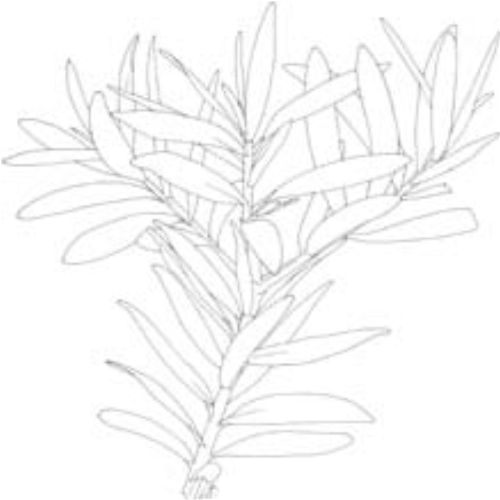 |
| Kauri. Illustration: Eleanor Burton. |
With fine weather for the first three days, Graeme Jane skilfully introduced us to the region, with trips to Mt Te Aroha, Opoutere Beach and Coromandel, culminating with a visit to Waiau Kauri Grove.
By then we had learnt what kauri associations and coastal forest look like, so a visit to Waiomu Kauri Grove on day 4 reinforced most of what we had learnt.
John Smith-Dodsworth’s presence, with his detailed knowledge of the region, was a boon. When looking at Kauaeranga Valley in detail, John could spot specimens that we would never have had the joy of seeing.
The weather deteriorated so that most of us did not reach The Pinnacles with Graeme and John. The following day, those of us camping had to wade a ford to obtain breakfast. We then spent a profitable day botanising on short walks in the valley, after all the Aucklanders had been rained out of their anniversary weekend outing.
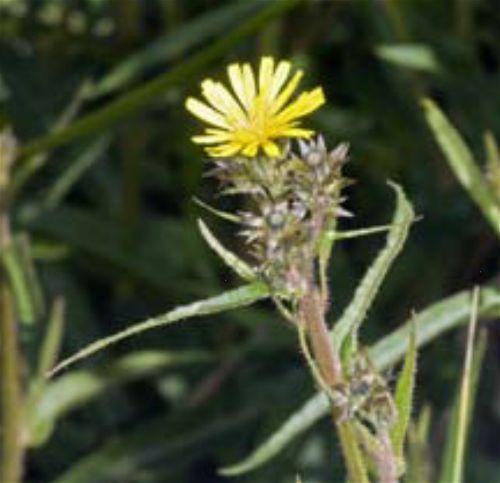 |
| Picris burbidgeae. Photo: Jeremy Rolfe. |
Sheelagh Leary had urged us to visit Miranda where she had recently studied. It was a treat! Our timing was perfect to look at the fattened godwits, and a substantial proportion of NZ’s remaining wrybills, feeding and preening themselves on the inner lagoon. The drive was also a chance to see the impoverished, below-sea-level, dairy farming of the Hauraki Plains; an interesting contrast with the isolated but functioning Kopuatai swamp vegetation we studied later that day. The final day at Pauanui, besides being a chance to see the devastation of estuarine in-filling for housing, was a wonderful chance to view the recovering vegetation of the peak above the town. There were many highlights and there, not 20m from the edge of a heavily used part of the reserve, we found the nationally endangered native ox tongue,
Picris burbidgeae. It was good that Graeme Jane could add this to his ever-growing plant lists, without which the trip would not have been nearly as enjoyable for many of us.
For once I didn’t have to rush home after the trip. Graeme kindly printed a plant list to enable me to explore Waharau Regional Park. Here I managed to practise the discipline of ticking off every plant I saw, as soon as I saw it. Until this trip, I had tended to look for only those plants I didn’t know – a bad practice! Not only does it not embed the names vaguely known, but it doesn’t help when trying to see if there is a plant that should be added the list.
Mick Parsons
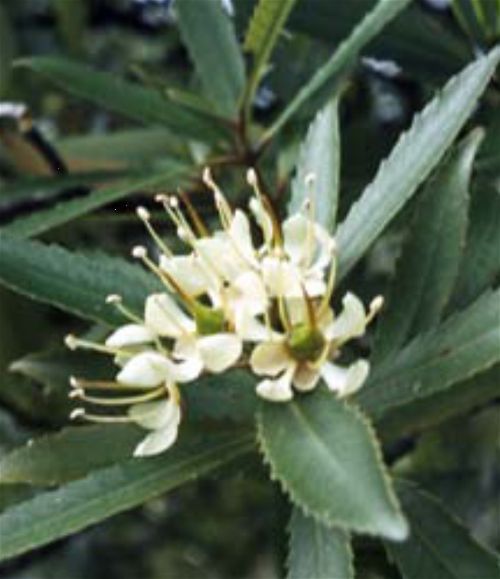 |
| Tawari / Ixerba brexioides. Photo: Barbara Mitcalfe. |
Day 1, 26/1/10: Coromandel Peninsula
Rather than go to the summit, which we had botanised before, we decided to take the well-graded “High-level Pack Track” and return by the “Buck Rock Track”. Apart from several patches of parataniwha /
Elatostema rugosum, our observations especially at the start were mostly weeds en masse, which was disturbing. However before long we began to note seedlings of northern tree species which we don’t see in the Wellington region, e.g.,
Ixerba brexioides / tawari.
Among fern additions were
Anarthropteris lanceolata,
Adiantum hispidulum and
Sticherus cunning-hamii. The shrub,
Rhabdothamnus solandri, was not uncommon, and in flower, trackside.
John Christeller
Day 1, 26/1/10: Mount Te Aroha via Waiorongomai incline
It was our first foray and our first sighting of a range of plants some of us had not seen before. We split into two groups; one covering the lower Waiorongomai valley, the other taking the direct route to the upper area of Mt Te Aroha, 953m, via the spur from the valley. To access the upper track meant skirting the bush for a way. There we had to distinguish
Deparia petersenii, a weedy fern here, from the more familiar
Paesia scaberula, growing next to one another on the edges of this disturbed forest. Further up the old rail incline we saw
Adiantum fulvum and
A. viridescens, together, which enabled us to identify them. Then past an avenue of
Gahnia lacera, and under a canopy that included mangeao /
Litsea calicaris and tawari /
Ixerba brexioides, both of which are fairly common in the Kaimai Range. Then came our first sighting of
Brachyglottis kirkii that later we often saw in kauri forests. Other understorey highlights included
Rhabdothamnus solandri, the pygmy cabbage tree /
Cordyline pumilio, and beds of
Asplenium lamprophyllum, along with
Blechnum fraseri. The striking club moss /
Lycopodium deuterodensum, aptly named puakarimu, was also common. At least seven
Hymenophyllum species were dotted along the moist banks of the cuttings; in particular some impressive
H. flabellatum. The fern allies
Tmesipteris lanceolata and
T. elongata hung from the trunks of tree ferns. We crossed many pristine side-streams, passed through an old rail tunnel, and then entered moister, higher, beech forests dominated by mixtures of the familiar
Nothofagus truncata and
N. menziesii. Mount Te Aroha has the northernmost stand of red beech,
Nothofagus fusca.
The time we took to acquaint ourselves with the northern flora during our climb of about 800m meant that most of us did not reach the summit, so we returned to the base of the mountain, seeing stunning views of the western Kaimai Ranges along the way; a brilliant introduction to the flora north of our normal reach.
Mick Parsons
Day 1, 26/1/10: Waiorongomai Valley
Rather than go to the summit, we took the well-graded “High-level Pack Track” and returned by the “Buck Rock Track”. Apart from several patches of parataniwha,
Elatostema rugosum, our observations especially at the start, were mostly of weeds en masse, which was disturbing. However before long we began to note seedlings of tree species which are not naturally-occurring in the Wellington region, for example
Ixerba brexioides, tawari. Among fern additions were
Anarthropteris lanceolata,
Adiantum hispidulum and
Sticherus cunninghamii. The shrub
Rhabdothamnus solandri was not uncommon in flower, trackside.
The bush and track edges included montbretia, hawthorn, ivy, Japanese honeysuckle, pines, gorse, blackberry, grey willow, creeping buttercup, selaginella and tree privet. Much of the montbretia had been sprayed, but so much more pest plant control is essential! When will DOC get adequate funding for this crucial task?
The bush is recovering from gold and silver mining in the late 19th and early 20th centuries. Work to restore the gold-miners’ Butler’s Incline and Ruby Track is well advanced, which added interest to our trip.
Barbara Mitcalfe and Chris Horne
Day 2, 27/1/10: Opoutere Beach Recreation Reserve and Wharekawa Harbour Sandspit Wildlife Refuge
Highlights of this fine, sunny day included:
• a coastal remnant forest featuring the rare tawapou,
Pouteria (
Planchonella)
costata, with pohutukawa, puriri, kohekohe and coastal flax
• dunes with healthy spinifex and pingao, dotterels, Caspian terns and variable oystercatchers
• very scenic area with Mercury Islands, golden sand and blue sea
• the mangroves,
Avicennia marina subsp.
australasica, named after Avicenna, Persian physician and scholar, 980-1037AD. He wrote “The Canon of Medicine”, used as a medical textbook for 500 years in Europe and the Middle East. It contained details of 650 plants used in the preparation of medicines.
• the mosses
Plagiochila and
Bazzania growing in an unusually dry habitat. We collected a specimen of the foliose lichen,
Parmotrema reticulatum, from a pine tree, and the fruticose lichen,
Usnea rubicunda, from among the mangroves.
Margaret Herbert
Day 3, 28/1/10: Long Bay Scenic Reserve; 309 Kauri Reserve
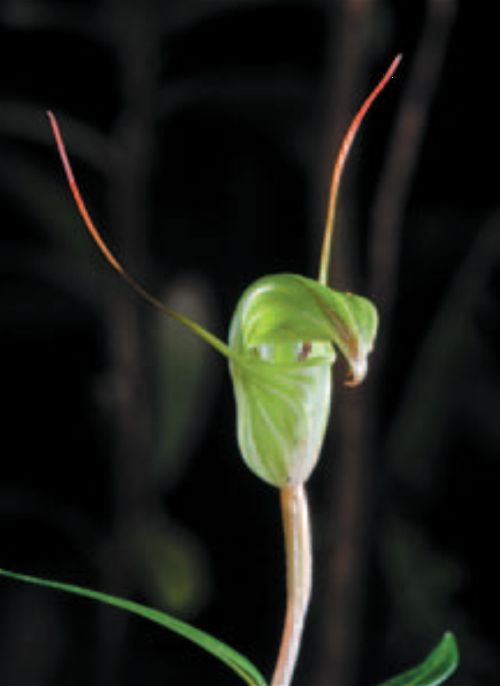 |
| Diplodium brumalum. Photo: Jeremy Rolfe. |
Another fine, warm day! We drove from Thames to Long Bay Motor Camp near Coromandel town. We botanised along the track at a botanist’s pace, discussing each new plant, such as the diff erence between
Coprosma spathulata and juvenile
C. arborea, and the adult and juvenile forms of
Nestegis lanceolata. The reserve is a small, but good example, in parts, of northern coastal bush, dominated by smaller trees such as kohekohe /
Dysoxylum spectabile, taraire /
Beilschmiedia tarairi, mamangi /
Coprosma arborea and two areas of young kauri rickers, c. 80- 100 years old, and one large, mature tree. This combination of trees proved interesting to many Wellingtonians. Other understorey plants of interest were
Corokia buddleioides,
Coprosma macrocarpa subsp.
minor,
C. spathulata,
C. rhamnoides,
Brachyglottis kirkii var.
angustior,
Mida salicifolia,
Alseuosmia macrophylla, and
Olearia furfuracea. Of the smaller plants,
Ichthyostomum pygmaeum and small, non-bifi d plants of
Schizaea bifi da, under kauri, caused considerable interest, as well as
Trichomanes elongatum along the upper valley and creek-side in dark bush. Unfortunately, at this time of the year, orchids are not in evidence, but in October and November there are many in fl ower under kauri, including
Cyrtostylis reniformis,
Diplodium brumalum and much
D. trullifolium. What is usually a 20-minute walk, took 2 hours to complete, such was the interest. We then drove to the kauri grove on the 309 road to Whitianga. This is a good remnant of the original kauri bush that somehow escaped the destruction of 100 years ago, and also, unlike the trees in Manaia Kauri Reserve, the trees here have not been chopped into at the base to extract kauri gum, so the trees have not rotted. About 10-15 large trees are easily accessible, and others are up the hillsides beyond, together with some large rimu and totara. The main understory trees are nikau /
Rhopalostylis sapida, kahikatea /
Dacrycarpus dacrydioides, mahoe /
Melicytus ramifl orus, Hall’s totara /
Podocarpus cunninghamii, tree ferns and occasional tawheowheo /
Quintinia serrata. Under the kauri is a diff erent plant community, the ground being thickly covered with kauri grass /
Astelia trinervia, and some
Pittosporum cornifolium, which is also a common epiphyte high in the kauri branches. In season,
Pterostylis agathicola grows under the kauri, but this time, the plant of most interest was not kauri, but its opposite in size, fan fern /
Schizaea dichotoma, in the bark litter at the base of the trees. Also of interest was
Tmesipteris sigmatifolia, never common, usually found on
Cyathea dealbata, but we found one plant on
Dicksonia squarrosa. Again, a usually 30-minute walk took about 2 hours, such was the interest.
John Smith-Dodsworth
Day 4, 29/1/10: Waiomu Kauri Grove Track – in others’ words
• Chris Horne: Uh huh – the fi rst bit of shade, and BotSoc stops!
• Graeme Jane: Typical Coromandel bush – gone over by mining, logging, farming – basically recovering from 150 years of rape and pillage.
• Julia Brook-White: (waving
Hymenophyllum rarum): You always fi nd something interesting when you go off the track for a pee.
• Sheelagh Leary: A disaster!! I’ve lost a filling, and swallowed it!!
• Julia Brook-White: What a bummer!!
• Syd Moore: (on
Lygodium articulatum / bushman’s mattress) They were bloody hopeful, those bushmen, you couldn’t even make a pillow!
• Anon: What!! The bryophyte people ahead of us?!
• Rodney Lewington: If it’s got teeth on the flap it’ll be
Marchantia pilata. But it didn’t. So it wasn’t.
We had lunch at the top of the track, in a beautiful grove of large kauri, and followed this by river swimming, beach swimming, and dinner at the best Chinese restaurant in Thames – a perfect BotSoc day.
Jill Goodwin
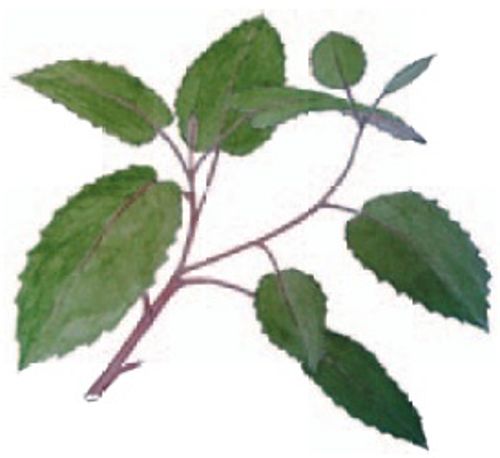 |
| Brachyglottis myrianthos. Illustration: Bryan Halliday. |
Day 5, 30/1/10: Upper Kauaeranga Valley
While eating our dinners on the Education Centre’s deck, we had great views of the steep country at the head of the valley, often bathed by the setting sun, so were looking forward to botanising up there. It was overcast as we set off for the smoothly rounded rock bluff s and high plateau shrubland. As we botanised up Webb Creek Track, numerous people passed us going to DOC’s 80-bunk Pinnacles Hut.
Most of the Coromandel was exploited for gold and kauri by the pioneers; here it was kauri. The logs were breached from a dam above steep Waterfall Creek, and cascaded several hundred metres to the valley fl oor, some shattering on impact. Near the dam was a sombre reminder, a 3m diameter kauri stump. Disappointingly, the summit of The Pinnacles, 759m, was engulfed in mist, then it began to drizzle. We descended via Billy Goat Track, seeing good views of Waterfall Creek. We saw
Celmisia adamsii var.
adamsii, which grows at much lower altitudes than other celmisias normally do,
Lindsaea viridis among rocks by running water,
Hymenophyllum minimum,
Brachyglottis myrianthos,
Gaultheria paniculata,
Pittosporum huttonianum,
Metrosideros albiflora, and the sundews
Drosera binata, and
D. spathulata.
Chris Hopkins
Day 6, 31/1/10: DOC Visitor Centre; Outlook ’67 Track; Catleys Track
This day began wet, so some people spent time at the impressive visitor centre, looking at the informative displays of all aspects of the valley’s natural and human history, and the remarkable, mind-numbing film of the kauri logging era.
As the weather improved, some people botanised short walks in the valley. Up Outlook 67 Track we saw tawa and northern rata, but on the descent to Whangaiteranga Camp we were dismayed to see Himalayan honeysuckle and purple pampas! Where is the funding for DOC to kill pest plants, including these two and tree privet, so common in the valley?
Catleys Track, which begins with a ford to the true left side of the Kauaeranga River, is along river terraces. It features numerous kahikatea, miro, totara and matai to 50 cm diameter. We saw no signs of logging, and believe that the forest upstream to the suspension bridge would be well-worth botanising.
Chris Horne
Day 7, 1/2/10: Miranda; Kopuatai Peat Dome
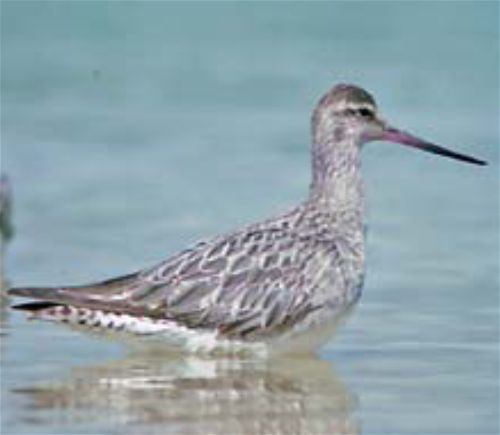 |
| Bar-tailed godwit. Photo: Richard Veitch © Department of Conservation. |
The weather at our foothills camp had deteriorated so we drove the Hauraki Plains, to visit the Miranda coast and Shorebird Centre.
The tide was high. The godwits, stilts, red knots and wrybills had moved onto the shell banks and ponds to wait for it to recede, and their mud-flat feeding area to be free of water again. Krystal, from the Shorebird Centre, was on hand with a viewing scope to show visitors the birds enlarged 60 times and explain what we were looking at. Although we didn’t see all 5800 godwits fly, groups of the smaller birds moved from place to place making impressive whirling patterns in the air. The godwits were plump, working their way to the obesity (fuel load) they need for the coming migration to their breeding grounds in Alaska. Some were already showing their rosy / brick red mating colour on their tummies.
We ate lunch at the Shorebird Centre which impressed us with its well equipped book store, visual displays, lecture facilities, library and accommodation. Keith Woodley, centre manager, and author of the recently published
Godwits: long-haul champions, talked to us for an hour. He explained the centre and its functions, then told us the story of E7. In brief E7, a satellite-tagged female godwit, left Miranda on 17 March 2007, flew 10,000 km non-stop to the Yellow Sea coast, refuelled for a few weeks, then flew 6,500 km to the Alaska breeding grounds. She was back in the Firth of Thames by 7 September. The round trip added up to 29,500 km. Keith was closely involved with monitoring E7’s flight and has been to the godwit breeding grounds himself. There’s nothing like a first-hand account of a great story to bring it to life!
Sheelagh Leary
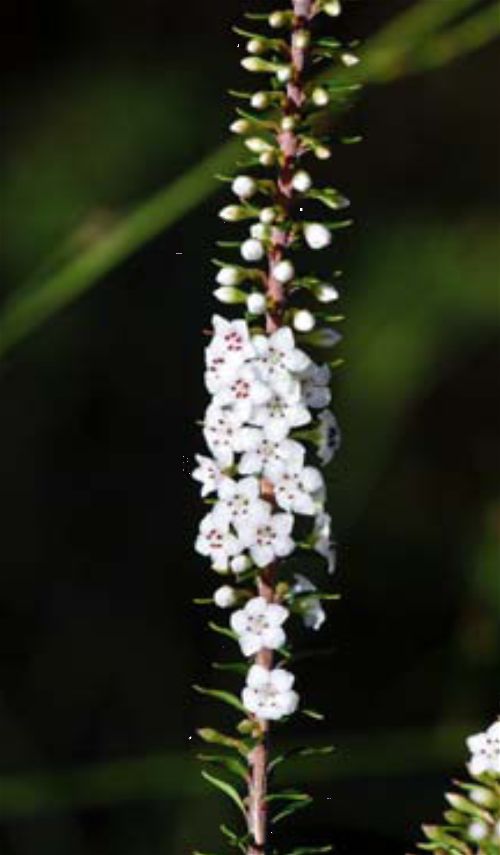 |
| Epacris pauciflora. Photo: Jeremy Rolfe. |
We then drove across the plains to Kopuatai Peat Dome. The Hauraki plains are an example of where the precautionary approach was never applied in attempts to make the most of farming the vast floodplains of the Waihou and Piako rivers. Large pumps now sustain farms which are now below the level of the former swamp forest; the stumps of which have long ago been ground off to make way for pasture. Stunted maize crops also occupy some of the area now struggling to deal with high water tables and salinity, and the roadsides are depositories of a suite of weeds not equalled anywhere! The Kopuatai wetland occupies the last 10,000 ha of the Hauraki Plains not devoted to agriculture. Our access was via Awaiti Canal Road and a walk along the canal to a weir system designed to regulate the water levels within the system. This entrance accesses the restiad peat bog at the eastern extremity of the wetland but still requires a walk past herds of dairy drystock and a weedy entrance. A new weed to us was American fireweed,
Erechtites hieracifolia, and then there were the groves of the invasive
Salix cinerea, along with the usual suspects. We entered a track overgrown with
Hypolepis distans, and were greeted by an avenue of
Dianella haematica resplendent with masses of blue berries. We saw under
Epacris pauciflora and
Coprosma tenuicaulis, large
Drosera binata and the rare
Lycopodiella serpentina. Our short foray ended amid a bed of
Empodisma minus fringed with
Sporodanthus ferruginea towering above us.
On the return walk we attempted to find, without success, the elusive and tiny
Wolffia australiana, in a slow-moving side-drain where it had been sighted previously. Instead we had an unrewarded slog through rampant browntop /
Agrostis stolonifera overlain with
Calystegia silvatica; the drain is now largely overgrown with gypsywort /
Lycopus europeus. This, however, did not detract from the privilege we all felt at seeing the few remaining treasures earlier.
Mick Parsons
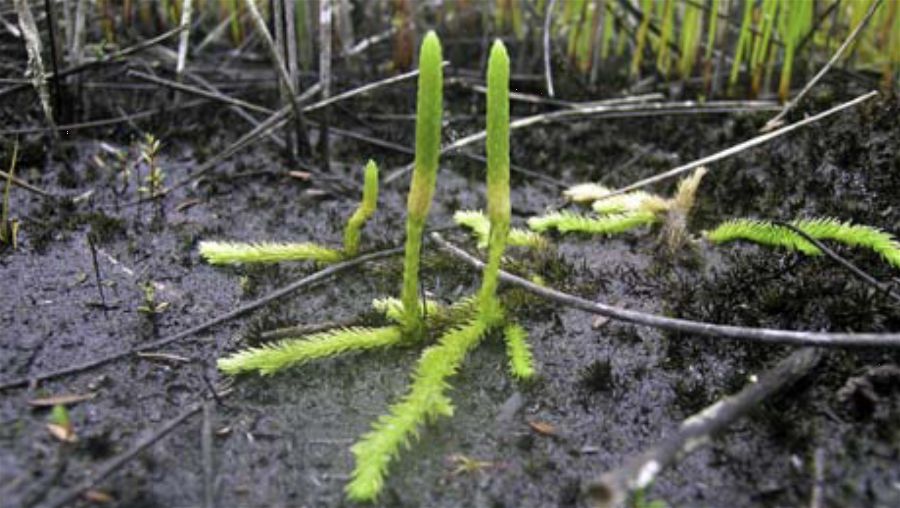 |
| Lycopodiella serpentina. Photo: Leon Perrie. |
Day 8, 2/2/10: Pauanui Trig Track
From the beach at the south end of Pauanui, the track led through a remnant of coastal forest with puriri and kohekohe growing from a jumble of boulders carpeted by hound’s tongue fern – now unromantically renamed
Microsorum pustulatum. Then we climbed steeply through scattered pine trees and scrubby vegetation – rather monotonous, but it gave me a chance to practise learning the differences between
Coprosma macrocarpa,
C. robusta and
C. grandifolia.
Sweating, we reached the summit, 387m, with a fine view and entered another small remnant of original forest, moist enough for filmy ferns to grow and dominated by northern rata. The track then led down the eastern face towards the sea through secondary vegetation.
Olearia townsonii was flowering, and orchids and lycopods grew amongst the rocks. Then it was back into scattered pines and scrub until the track reached the rocky shore.
Rengarenga,
Arthropodium cirra-tum, hung from banks above the beach, to the delight of Wellingtonians unfamiliar with it. Exposed on the beach were platforms of hexagonally jointed basalt, reminders of the violent volcanic origin of this coastline. It all made for botanical and scenic variety and a good day out.
Ann Graeme
Participants : Margaret Aitken, Peter Beveridge, John & Donna Christeller, Rae Collins, Gavin Dench, Gael Donaghy, Glenys Evans, Ken Fraser, Ian & Jill Goodwin, Ann Graeme, Bryan & Robin Halliday, Margaret & Richard Herbert, Chris Hopkins, Chris Horne, Priscilla Isaacs, Graeme Jane, Brenda Johnston, Allison Knight, Sheelagh Leary, Rodney Lewington, Barbara Mitcalfe, Chris Moore, Syd Moore, Mick Parsons (leader), Sunita Singh, Val Smith, John & Nerrisa Smith-Dodsworth, Julia Stace Brook-White, Yvonne Weeber, Beryl Young.

 Site Index
Site Index







 Site Index
Site Index





